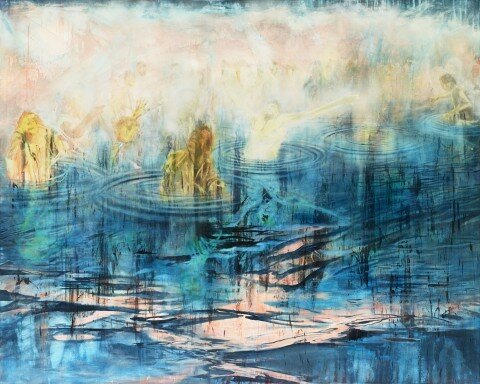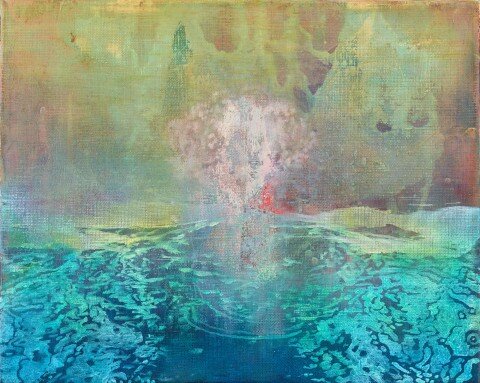1st Venice Triennale in the name of Freedom in the Art
NATURA NUTRIX – HOMO VORAX
Palazzo Albrizzi
Assoziazione Culturale Italo-Tedesca
Cannaregio 4118
30121 Venezia
http://www.acitve.it/
http://www.valorizzazioniculturali.com/palazzo-albrizzi-english/
Bernd Kirschner – Rituals
Although Bernd Kirschner is dedicated to representing natural landscapes, one seeks in vain in his paintings a calming influence. He gives, rather, the impression that all his objects are in gentle motion. Whether it is the surface of water, which gives to almost all his work the image base and also plays a role which can only be comprehended metaphorically, or the people, or the vegetation or the hinted-at airflows: the spectator always feels a vague, hard-to-define restlessness that comes less from the image than that they are the conscious result of a willful approach to the picturesque. Bernd Kirschner limits his palette to a few colors, especially blue and a delicate red, which he applies to the canvas in many layers. Fine glazes allow for deeper layers of color to shine through and give the space depth. They then again surprise us with resolutely set brush strokes, and then again with casually but deliberately placed reflections, miniscule streams of paint, drops, gobs and blots; these structure certain areas of texture and trigger restrained emotions which cause the entire composition to vibrate. Kirschner detects the physical appeal of life-giving and life-destroying water, the strongest and most versatile of the elements, making it the scene of fundamental physical and mental experience – for example in the painting to which he has given the title Rituals. He calls attention to an un-locatable situation which remains mysterious despite this supposedly clear title. A number of isolated male figures, naked or clothed, are moving in a body of water. It remains unclear what impact, voluntary or enforced, this swim or bath is having on the players in the illustrated silhouette, because while one person is ecstatically and rapturously spreading his arms, his companions, or rather fellow sufferers, are obviously struggling with their fate, and they seem unable to come into contact with each other. Expectant eyes turn upwards toward a phenomenon hidden from the viewer, while their bodies seem to evaporate in a diffuse reddish-white fog. Are we experiencing rebirth, purification or destruction? Although the anonymous figures, with one exception, are standing up to their hips in wetness, and are only slightly in motion, concentric circles of water surround their bodies with varying radii. Bernd Kirschner repeatedly incorporates such ornamental elements in the structure of his composition and simultaneously demonstrates a technical skill which is so dominant in his interaction with photographic models, to which he is able to lend in his painterly transformation the illusions of fictitious world.
Jean-Yves Klein – Perse
With his recently created sculptural work, Jean-Yves Klein joins those painters who have been experimentally investigating the intensive study of sculpture since the revival of expressive-figurative tendencies. The main protagonists of this tendency are Georg Baselitz, A. R. Penck and Markus Lüpertz. They temporarily reversed the activity in front of the canvas with the power-sapping work in the sculpture studio and with the presentation of three dimensional images. While those summarized their exported in bronze and often colored wood sculptures, the Canadian-born Klein had a different kind of solution for the surfaces. He attacks the larchwood blocks with axes and chainsaws and beats the soft surrounding lead with hammers. He then covers the hardwood core with a tight-fitting jacket of soft rolled lead, behind which nicks, gaps and splintery cracks are hidden from the process. The partially rugged physicality of the original material completely disappears under the dull sheen of a smooth surface; the natural substance of lead is forced into the nooks, crannies, crags and ridges which come from the use of the heavy tools. Klein knows how to deal with the exciting contrast of density, elasticity, insubordination and flexibility. He focuses on the unusual way he treats his materials and draws out attention to the mild light reflections and shadows on the gray surface which has ‘tamed’ the inner core. He gains individual leeway not only in terms of his formal method of arranging of plastic mass – by highlighting, for instance the basis which accentuates the statuary character of the figures he portrays and the avoidance of a ‘show’ side, but he also works on his figures in terms of content or substance. Thematically, Jean-Yve Klein’s sculptures can be considered, on the one hand, to be centered around his central motif, the ‘feminine’, be it with paper, canvas or in ceramics, but also in relation to suggestions from Greek mythology and its protagonists. The title Perse alludes to Persephone, the attractive goddess of the underworld, who was delivered for a few months at the behest of Zeus under the name Kore from the realm of Hades and was allowed to stay with her mother, the fertility goddess Demeter. Without getting lost in the narrative context, Klein describes the emotional appearance of a woman on a cantilevered construction base. Her face and expressive, extruded mouth may be modeled on an African mask; the upper part of the dress is torn and her breasts are free. There is no trace of the classical ideal portrait. Perse poses on the helmet of a stylized warrior, standing there with legs apart, who takes no notice of the woman and directs his stern look at the viewer. His presence refers to the historical-mythical background, which Klein, as in all his fragmentary episodes, keeps to himself.
Sabina Sakoh – May ‘15 – in Private
The arrangement of Sabina Sakoh’s compositions is multilayered. The scenic courses of action in her paintings are entangled, and the contents elude a valid interpretation. The artist seduces us viewers into worlds of dream, whose compliecated iconography refer both to current, subjectively interpreted problems and to imperishable themes.
As hinted at in the contemporary manner of execution, which is due to the act of painting and a resourceful sampling of artistic and stylistic points of view, the organization of pictorial elements reveals the striking importance of diverse sources of inspiration from the past. Sabina Sakoh reaches back to typical representational patterns, those which characterize Mannerism, the Baroque and the painting of the 19th century, and places them at the service of her creative concepts.
The result of this original and alert absorbtion is a vitality and depth, the dramatic distribution of light and shadow, the symbolic formulations of exalted gestures of a grotesque personage and a precision with which she captures details. Her work May ‘15 – in private includes all these properties. At first you think you are faced with a bucolic pastoral scene. A young man, casually resting and stretched out in the country, has briefly interrupted reading a book; he looks up, he is wearing fashionable sunglasses. He seems complacent. He is dressed in green-brown, it is camouflage; he is obviously a combattant who has apparently and obtrusively entered into this idyllic and captivating space, the character of which he both ignores and disturbs. Otherwise, the precarious situation he is in would be clearly visible. In contrast there is a woman kneeling behind his head, and a partly concealed observer, looking for protection. This is a simulacrum, a sham, whose aggressive gestures reveal a reversal of the seemingly peaceful situation. Excited by this vision, she raises both hands in a gesture of horror, defense and surprise considering the being clad only in a loincloth whose luminous skin tone is in stark contrast to the subdued tone of the painting. Using a branch, this unruly demon ignites the nearby undergrowth and dips the center in a peculiarly glaring, ominous light. The painter pays special attention to the phenomenon of the sky, which lends the scene a special kind of light. While the apparition behind is captured by a looming storm cloud that emphasizes its physical appearance, a deep blue sky, interwoven with white and red veils, rises above the tree tops. Sabina Sakoh has borrowed these colors from Michelangelo’s ‘Day of Judgement’ of the Sistine Chapel. With this dramatic detail she gives her viewers another interpretation clue.
Jürgen Schilling
-
-
-
Wisdom from the Deep, 2015
Oil on canvas, 40 x 60 cm1st Triennale, Palazzo Albrizzi -
-
The Evidence of Things, 2015
Oil on canvas, 40 x 60 cm1st Triennale, Palazzo Albrizzi -
-
Space for your Future, 2015
Oil on canvas, 24 x 30 cm1st Triennale, Palazzo Albrizzi






